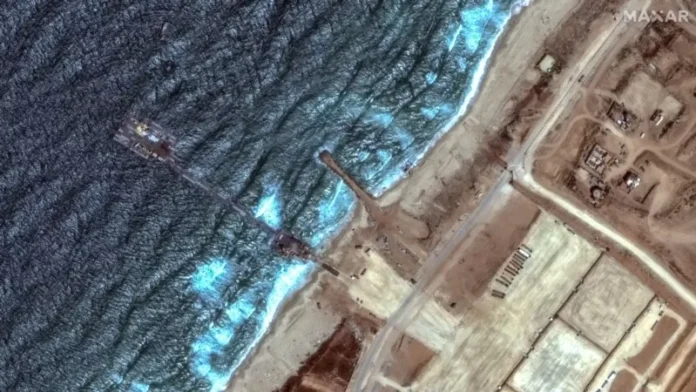Washington, D.C. – U.S. President Joe Biden continues to push forward with plans to aid Gaza despite internal warnings, as a watchdog agency reports on the troubled state of the designated aid pier. The White House stands by the decision, calling it a comprehensive response to a dire humanitarian crisis.
President Biden has expressed disappointment with the performance of the U.S. military-operated pier, which has had to be removed from shore multiple times due to inclement weather conditions. However, a report released by the U.S. Agency for International Development (USAID) on Tuesday indicates that there were prior concerns raised about rough seas and security challenges before the decision was made to deploy the problematic pontoon.
According to the report, “multiple USAID staff expressed concerns” about the pier being a distraction from pushing Israel to open land crossings, which is a “more efficient and proven” means of delivering aid to the desperate people of Gaza. However, once President Biden issued the directive to proceed with the aid pier, the focus of the Agency shifted towards using it as effectively as possible.
In response to the report, the White House stated that the pier is just one part of a larger, comprehensive effort to address the dire conditions in Gaza. National Security Council spokesman Sean Savett emphasized the impact the pier has had, stating that it has delivered nearly 9 million kilograms of food and water and has “significantly helped alleviate” the dire situation in northern Gaza. He also expressed gratitude to the U.S. military for their dedicated efforts in building and maintaining the pier.
The decision to build the aid pier was announced during President Biden’s State of the Union address in March, as Israel had at the time halted deliveries of aid through land crossings. However, the USAID report states that the troubles with the pier ultimately caused it to “fall short” of its intended goal of providing enough aid for half a million Palestinians for three months, instead only being able to supply enough for one month’s worth.
The report reveals that the aid pier was only operational for a total of 20 days out of the two-month period before it was decommissioned. The main issue, as stated in the report, was the challenging weather conditions, with the pier being detached or shut down numerous times. Additionally, the watchdog agency points out that the initial planning meeting had discussed using the pier only in short or moderate waves, yet the Mediterranean frequently experiences “significant” winds and waves.
Security concerns in an active war zone also played a significant role in hindering aid delivery through the pier. With Israel launching attacks on Hamas following the October 7th attacks, the report states that the ongoing conflict “significantly impacted” the aid delivery efforts through the pier.
Despite the challenges faced with the aid pier, it’s important to recognize the immense efforts and dedication put forth by the U.S. military in building and maintaining it. The pier has provided a significant amount of aid to the people of Gaza, and has offered a glimmer of hope during a critical time.
The decision to construct the aid pier in the midst of ongoing conflict and severe weather conditions demonstrates the commitment of the Biden administration to providing much-needed assistance to those in need. It’s a testament to their determination to respond compassionately and effectively to humanitarian crises, and it sets a positive example for other nations to follow.
In conclusion, while there may have been some challenges with the aid pier for Gaza, it’s clear that the decision to build it was a necessary and impactful one. Thanks to the efforts of the U.S. military and the Biden administration’s commitment to addressing the dire situation in Gaza, millions of kilograms of essential aid have been delivered and lives have been positively impacted. Let us continue to support and encourage such efforts as we work towards a better future for all.

